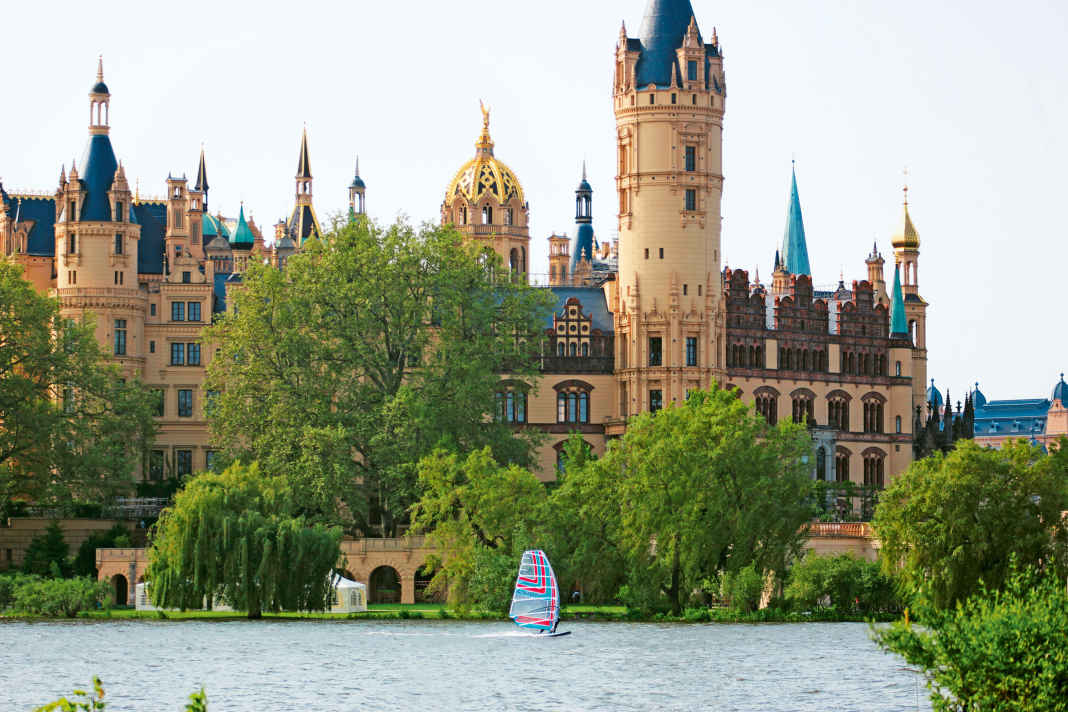





We windsurfers are constantly on the lookout - for more exotic, unknown spots, higher waves and more wind. All the wanderlust, the pictures in the magazines, the constant streaming of videos - all this often makes us forget that the good stuff is often so close. A good example of this are the countless lakes located in the heart of Mecklenburg-Vorpommern: every windy weekend, surf addicts rush up to the Baltic Sea, with very few looking left or right.
But I made my first attempts at surfing right here about 20 years ago on a pond just a few kilometres from my house - Lake Plau. As a schoolboy, I would ride my moped and trailer to the water after school and practise the freestyle moves that were popular at the time: carving 360s, duck tacks and willy skippers on a 2.70 metre Fanatic Bee. After surfing, my cousin and I would visualise what the spots on the Baltic Sea would look like. It was a different world for us back then. We dreamed of long sandy beaches and real waves, the kind we only knew from surf magazine.
All we wanted was to finally get away from our little lake and go surfing on the open sea. We did a lot of convincing with our parents and consulted the sea weather forecast before every weekend or listened to the forecast on the radio - that's how it was back then without the internet. Unfortunately, we didn't often find the conditions we had hoped for at the Baltic Sea. Only rarely did the almost unique coincidence of fate occur that a weekend off work for our parents correlated with a suitable wind forecast. Much more often, however, it remained a weekend at Lake Plau and we made the best of the conditions with our big racing sails. As we kept our equipment at a campsite right on the lake, we were able to take advantage of almost every gust. When the wind picked up, we simply jumped into the Neos, took the equipment we had set up and off we went.
During the course of my studies, things changed: the Baltic Sea and the surrounding Bodden waters became my home spots and I had to watch as more and more spots became overcrowded with kiters and a hectic pace on the water became the order of the day instead of relaxation. I often found myself longing for the calm, familiar atmosphere that I knew from Lake Plau. Years later, on a day with very southerly winds, which are hardly usable on the Baltic Sea, I drove south on the A19 instead of joining the traffic jam on the B105, which brings holidaymakers from all corners of Germany to the Darß.
When I arrived at the lake, I relaxed and glided across the water, surrounded by green forests and meadows, bringing back childhood memories. The colour and smell of the water, the chirping of the birds - you felt like you were in the middle of a scene that couldn't have been more idyllic.
It is not without reason that the Müritz National Park is one of the largest in Germany. Here you can encounter white-tailed eagles, moor oxen and raccoons. To ensure that the biodiversity and ecological balance of the region are not disturbed, large parts of the lake landscape are marked as nature reserves with yellow buoys. As windsurfers, however, we have a very harmonious relationship with nature. The sport makes hardly any noise, produces no pollutants and utilises one of the most natural energies on earth - the wind.
After years of abstinence, "my" lake has won me back as a real fan. I realised that there can also be great surfing conditions inland. It's about more than just surfing with blinkers in front of your eyes, without looking to the right or left. It's about the overall experience. In spring, bright yellow rapeseed fields bloom under a bright blue sky over dark green water, and in the evening the sun sinks red on the horizon. This is one of the reasons why the Mecklenburg Lakes have become a place of longing for many nature lovers.
There is also plenty on offer for windsurfers. On the one hand, the large selection of spots is impressive. There really are an infinite number of waters here, which are often even connected by rivers that can be navigated by boat. A surf safari by boat, where you simply anchor at the spot of your choice and go surfing, is easily possible on the lakes. Houseboats, which also have space for surfing equipment, can now also be hired without a boating licence. This is both a blessing and a curse. Because more and more boats are making their way through the waterways of the lakes every summer.
However, the better windsurfing spots on the lakes are avoided by many skippers due to the steep waves. And the good spots are really numerous and not difficult to find.
It would be impossible to list all the potential spots. Because writing a spot guide about the Mecklenburg Lake District that claims to be exhaustive must inevitably be a Sisyphean task. Seen from above, the landscape of Mecklenburg-Vorpommern is almost reminiscent of a cheese with lots of holes. Countless lakes characterise the landscape. They are often small and surrounded by forests, but some of them are among the largest in Germany, above all the Müritz, which is known to be the largest body of water on German soil, ahead of Lake Constance.
From stormy autumn winds to balmy summer thermals from the east, everything is there. The mood at the spots changes with the wind and weather. A glance at the map will tell you where to go in which direction. So the next time you're rushing north, stuck in a traffic jam or find the Baltic Sea too wild, just turn off earlier and have fun in the second row. The good things are often very close, you'll see.
Mecklenburg Lake District - the best windsurfing spots
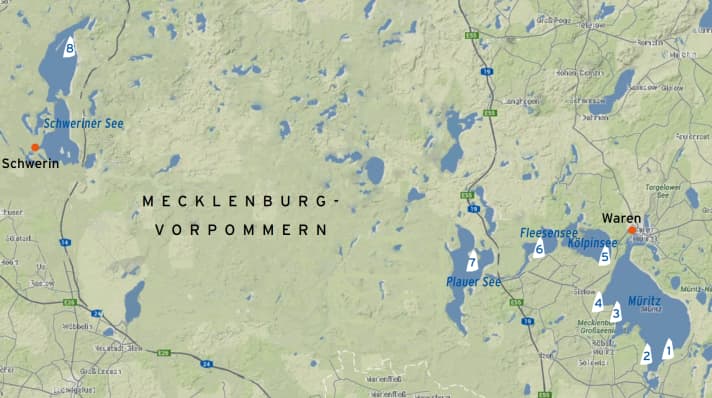
1) Müritz/Boek
At the most popular spot on the Müritz, Boek (1), a very good wind wave builds up with ventilation from westerly and especially north-westerly directions. This chop is really fun and invites you to do freestyle tricks and loops. In addition, the bottom here consists of soft sand, which also proves to be a real blessing when getting in. Wave beginners who are not yet confident about surfing on the Baltic Sea are recommended to travel to Boek on a day with six to seven wind forces from the north-west. There is also a large campsite with the usual facilities right next to the spot.
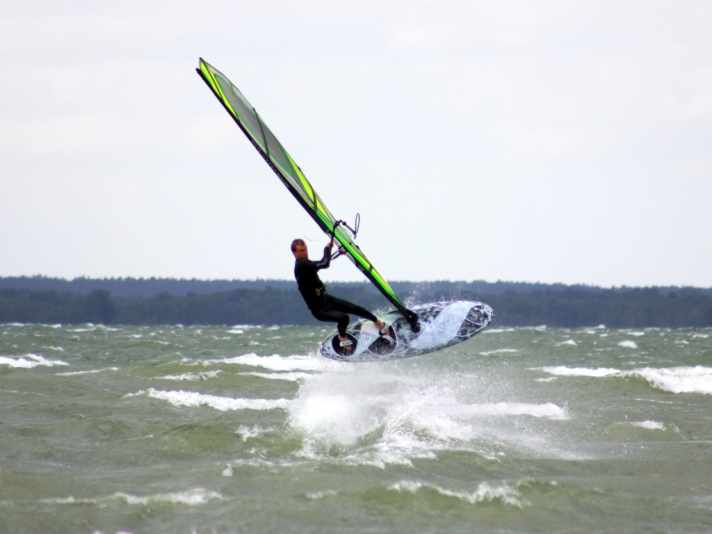
2-4) Müritz/Ludorf (2), Nitschow (3) & Sietow (4)
Alternatives to Boek. All three spots have one thing in common: you can stand on a campsite right by the water and there is beautiful flat water with the best freeride and freestyle conditions. Our recommendation: Ludorf and Nitschow from north-east to south-east, Sietow only from north-east.
5) Kölpinsee
If you like it a bit calmer than Boek, you can head to the eastern shore of Lake Kölpin (25) if the wind is blowing from the west to north-west. Here you will find a nice standing area, although the bottom is quite stony and you will have to reach into the repair box in case of nose dives or hard touchdowns with the fin. In addition, you should only stay in the area in front of the entrance at Kölpinsee, as the southern and northern shores are nature reserves that are not allowed to be used. The waves at Kölpinsee are no longer as big as at Müritz and you can cruise in a relaxed manner or bust out a few freestyle moves. Incidentally, "Kölpin" is the Slavic name for a swan. However, there were no sightings of them during our visit. The wind would probably have caused them some problems anyway.
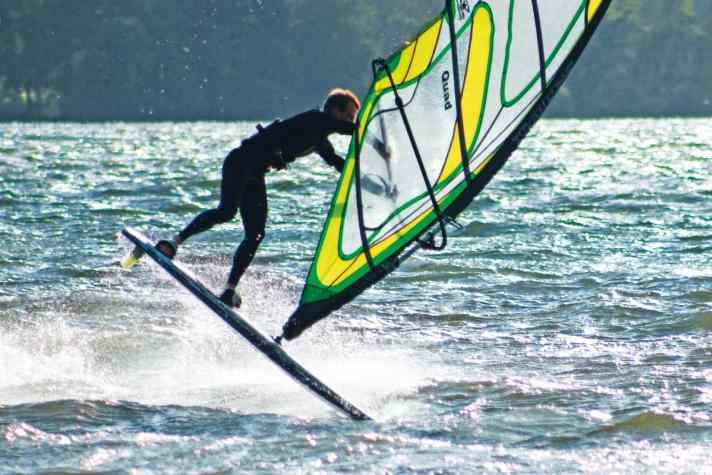
The entry point can be reached from the village of Klink. The car park is located on a hill and offers a beautiful view of the lake, but is a few minutes' walk from the water, so you have to walk a bit. You can rig up right by the water in the shelter of a few rustic trees.
Especially in early summer, the lush greenery at Kölpinsee is a real feast for the eyes. Time seems to have stood still a little here. Apart from vast fields, rustic trees, swamps and moors as well as a few scattered villages, there is little to see. But this is precisely why lovers of the area come here. I was also mesmerised by the unspoilt nature of the landscape. The steady wind did the rest.
6) Fleesensee
The Fleesensee is best known for the Club Robinson, which is located here and even has something like a small surf school. However, I'm not sure whether the instructors actually surf, as you always spend the sessions here on your own. The lake works very well with winds from the west and east. If the wind blows from the west, the spot can cope with more southerly winds than Kölpinsee. Parking could cause problems here. Due to the holiday resort and the peace-loving residents, there are actually no legal parking options near the water. If necessary, you have to load your equipment onto a trolley and park at the top of the hill at the entrance to Göhren, or park "undercover" in Untergöhren near the lake. As a windsurfer, you are more of a curiosity here, as the number of golfers outweighs you by quite a bit. Nevertheless, there is a beautiful sandy beach right next to the Club Robinson beach bar, from where you can easily take off and then do a few manoeuvres in front of cocktail-sipping package holidaymakers.
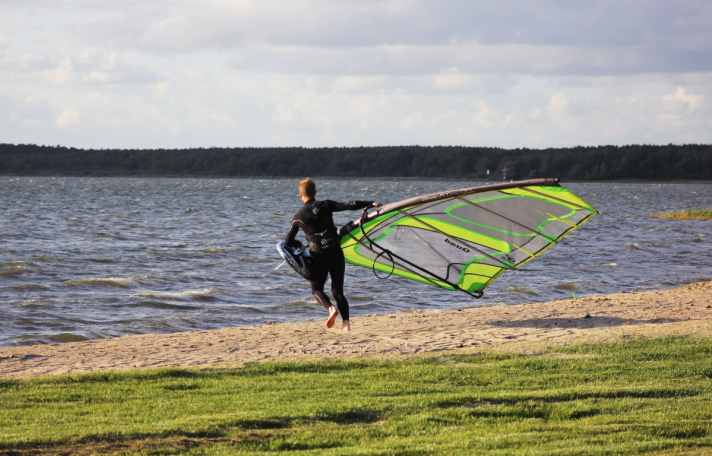
7) Lake Plau
Works best in very southerly winds, which are often just as strong as on the Baltic Sea. Westerly and north-westerly winds are less ideal, whereas early summer north-easterly breezes are a dream for freeriding. The main entry point for windsurfers, which is very popular, is on the island of Werder. In front of the forest, which has been enlarged by artificial tree plantations that now extend right down to the water's edge, there is a small windward jam, but also a fairly large standing area. However, you can surf south towards Lenz to get a clearer wind and better chop. However, you will then also be surfing in the fairway, which is particularly busy when the weather is nice.
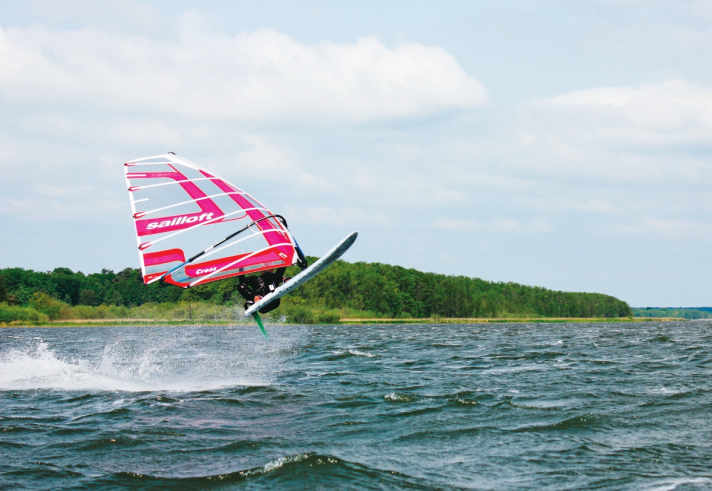
8) Lake Schwerin / Flessenow
The best-known spot on Lake Schwerin, with a constant south-westerly wind and a nice chop for jumping when the wind is strong. Standing area at the entry point in front of Seecamping Flessenow (2.50 euros/day). A little further north, you can access the water for free via a meadow. West to north is also possible, the water is then perfectly smooth, although the offshore island of Lieps then reduces the wind a little.
Surfing in front of the Mecklenburg State Parliament is a special experience. Although the wind is often a little gusty here and you share the water with numerous other athletes, the backdrop and ambience are really something special. So while draft legislation is being debated in the background, you can enjoy jibing in the foreground. The best wind direction for this is north-east.
Area information Mecklenburg Lakes
Arrival
The spots in the Mecklenburg Lake District are strategically located, often close to the motorway. The spots are therefore ideal for a short detour on the way to the Baltic Sea.
Wind, weather & neoprene
Like all spots in the north, the Mecklenburg Lake District is dependent on the general weather conditions. If the Baltic Sea comes under the influence of low pressure, it also gets windy here. However, the wind usually blows one to two wind forces weaker than at sea, which can sometimes be an advantage. However, there is no need to worry about crowded spots here. The region is also regularly ventilated during the early summer north-easterly phases, which can last for weeks on end, but then usually at a moderate ten to 15 knots.
In summer, a 4/3 neo is usually sufficient, in spring and autumn a thick wetsuit and shoes are a must. In spring, the shallow waters warm up much quicker than the Baltic Sea, so you can also unpack a shorty during a warm phase. However, a storm with cold weather quickly turns the tables again.
Living & Camping
The region is well developed for tourism and there are numerous guest rooms and hotels in all price ranges. There are also numerous campsites, some directly at the surf spots, where you can easily spend the weekend. Here is a small selection:
Nine different places in the region at www.haveltourist.de
Alternatives:
- www.weicamp.de (Müritz)
- www.campingplatz-naturfreund.de
- www.mueritz.com (Müritz)
- www.m-vp.de (Müritz)
- www.seecamping.de (Lake Schwerin)
There are numerous other campsites, but naming them all would go beyond the scope of this article. Just google the search terms "Camping Müritz" and you'll find what you're looking for.
Surf schools
- There are surf schools at almost all of the lakes presented here, with the exception of Lake Kölpin.
- On the Müritz you will find the Surfmühle in Boek (www.surfmuehle.de)
- The surf school on Lake Plau is located in Quetzin: www.wassersport-plauer-see.de
- At Fleesensee, you can hire equipment and book surfing lessons through the local Club Robinson. www.robinson-fleesensee.de/leidenschaftliche-aktivitaeten/wassersport/

